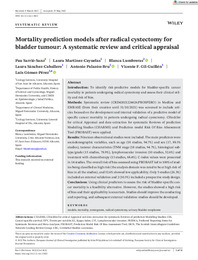Título :
Mortality prediction models after radical cystectomy for bladder tumour: A systematic review and critical appraisal |
Autor :
Sarrio Sanz, Pau 
MARTINESZ CAYUELAS, LAURA 
Lumbreras, Blanca 
Sánchez Caballero, Laura 
Palazón-Bru, Antonio 
Gil-Guillén, Vicente F 
Gómez-Pérez, Luis  |
Editor :
Wiley |
Departamento:
Departamentos de la UMH::Salud Pública, Historia de la Ciencia y Ginecología
Departamentos de la UMH::Medicina Clínica |
Fecha de publicación:
2022-05-25 |
URI :
https://hdl.handle.net/11000/34569 |
Resumen :
Introduction: To identify risk-predictive models for bladder-specific cancer mortality in patients undergoing radical cystectomy and assess their clinical utility and risk of bias. Methods: Systematic review (CRD42021224626:PROSPERO) in Medline and EMBASE (from their creation until 31/10/2021) was screened to include articles focused on the development and internal validation of a predictive model of specific cancer mortality in patients undergoing radical cystectomy. CHecklist for critical Appraisal and data extraction for systematic Reviews of prediction Modelling Studies (CHARMS) and Prediction model Risk Of Bias ASsessment
Tool (PROBAST) were applied. Results: Nineteen observational studies were included. The main predictors were sociodemographic variables, such as age (18 studies, 94.7%) and sex (17, 89.5% studies), tumour characteristics (TNM stage (18 studies, 94.7%), histological subtype/ grade (15 studies, 78.9%), lymphovascular invasion (10 studies, 52.6%) and treatment with chemotherapy (13 studies, 68.4%). C-index
values were presented in 14 studies. The overall risk of bias assessed using PROBAST led to 100% of studies
being classified as high risk (the analysis domain was rated to be at high risk of bias in all the studies), and 52.6% showed low applicability. Only 5 studies (26.3%) included an external validation and 2 (10.5%) included a prospective study design. Conclusions: Using clinical predictors to assess the risk of bladder-specific
cancer mortality is a feasibility alternative. However, the studies showed a high risk of bias and their applicability is uncertain. Studies should improve the conducting and reporting, and subsequent external validation studies should be developed.
|
Palabras clave/Materias:
models
mortality
nomograms
radical cystectomy,
urinary bladder neoplasms |
Tipo de documento :
info:eu-repo/semantics/article |
Derechos de acceso:
info:eu-repo/semantics/openAccess |
DOI :
10.1111/eci.13822 |
Publicado en:
Eur J Clin Invest . 2022 Oct;52(10):e13822 |
Aparece en las colecciones:
Artículos Medicina Clínica
|

 La licencia se describe como: Atribución-NonComercial-NoDerivada 4.0 Internacional.
La licencia se describe como: Atribución-NonComercial-NoDerivada 4.0 Internacional.
.png)